Today we’re taking a look at the sculptures of Liberdade Avenue – West. These art pieces are of different styles and times and are located in one of the most beautiful arteries of Lisbon.
On the axis of Baixa/Liberdade, between Marquês de Pombal Square and Restauradores Square, lies Liberdade Avenue – a leafy road with magnificent historic buildings, concert halls, hotels, terraces and shops of the most prestigious international brands.
This is where the most important official celebrations and festivities are held, as well as the traditional parade of the popular marches during the Lisbon Festivities.
Perhaps you’ve crossed this avenue many times and you can even enumerate some of the sculptures. But what if we told you that on this article about the west side alone, we’re revealing six points of interest?
And what if we told you that on our next article The Sculptures of Liberdade Avenue – East we’ll be sharing seven more art pieces?
For your best convenience, we suggest you start this walk in Marquês de Pombal Square and go down Liberdade Avenue on the right side.
Join us on this stroll and be enchanted by this fascinating artery of the city of the Seven Hills, particularly by the sculptures of Liberdade Avenue – West.
Get to know Lisbon’s historic neighbourhoods in a guided tour and discover unmissable places of this magnificent city.
Tributes and Ornaments: Sculptures of Liberdade Avenue – West
We can consider that the sculptures of Liberdade Avenue have two essential purposes: paying tribute and decoration. For that reason we’ll find respectively figure sculptures or busts of important personalities and decorative or allegorical elements.
Right at the beginning of the avenue there’s a set of four modernist figure sculptures, requested by the City Council of Lisbon and inaugurated in 1950, with the purpose of paying tribute to writers of the 19th century.
They’re all located on the same crossing, two on the east side and other two on the west side.
It’s with these latter ones that we’re starting our walk.
The Figure Sculpture of Alexandre Herculano
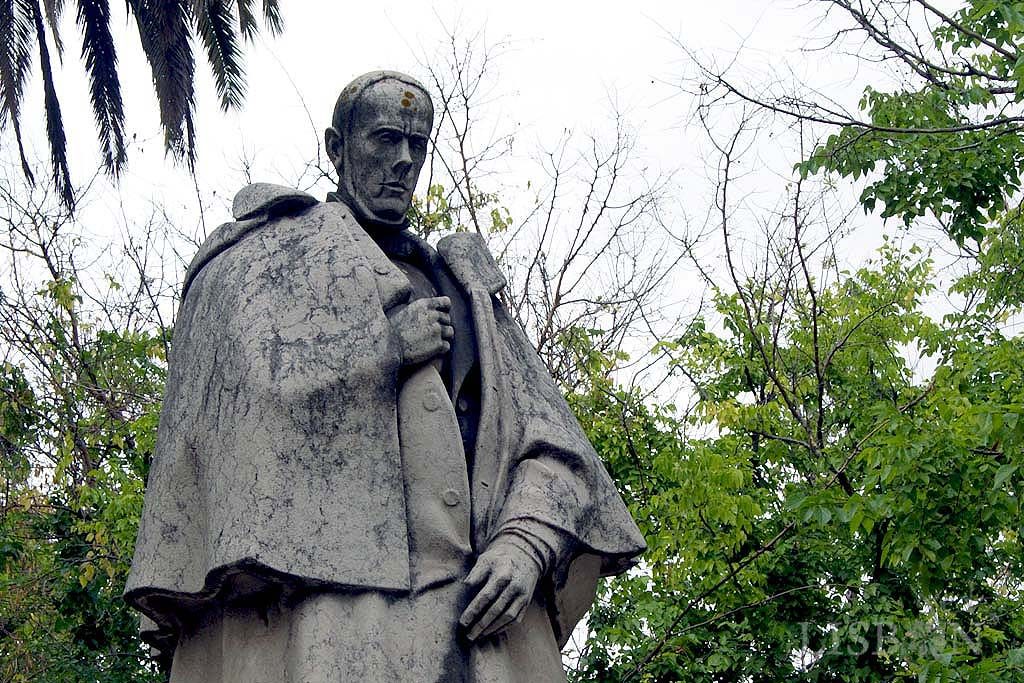
When crossing Rua Alexandre Herculano we find the first figure statue, which represents the illustrious liberal, writer, historian and journalist of the Romantic era Alexandre Herculano (1810-1877).
This big statue (2.88m), was executed in marble between 1945 and 1946 by the sculptor Salvador Barata Feyo (1899-1990).
The work of this artist of the second generation of the Portuguese modernism who did many pieces ordered by official institutions, has had more impact in the city of Porto.
In Lisbon, in addition to this one, we can see the statue of Antero de Quental in Estrela Garden.


The Figure Sculpture of António Feliciano de Castilho

Up next we have the tribute to the ultra-romantic writer António Feliciano de Castilho (1800-1875). He was a defender of the classic and conservative principles during the famous literary controversy “Questão Coimbrã”, in opposition to the new generation of realist writers such as Antero de Quental.
Castilho was blind since he was six years old and that is clearly represented in this art piece of 1948 by Leopoldo de Almeida (1898-1975).
This sculptor was also part of the second generation of modernists and many of his works followed the Estado Novo (nationalist corporatist authoritarian regime installed in Portugal from 1933 to 1974) aesthetic. He’s the author of emblematic artworks such as: the Monument of the Discoveries in Belém; the Equestrian Statue of King João I in Fiqueira Square; the Monument of Calouste Gulbenkian, in the garden of Calouste Gulbenkian Foundation in Berna Avenue; among others.
The Sculptural Set of Tribute to Rosa Araújo
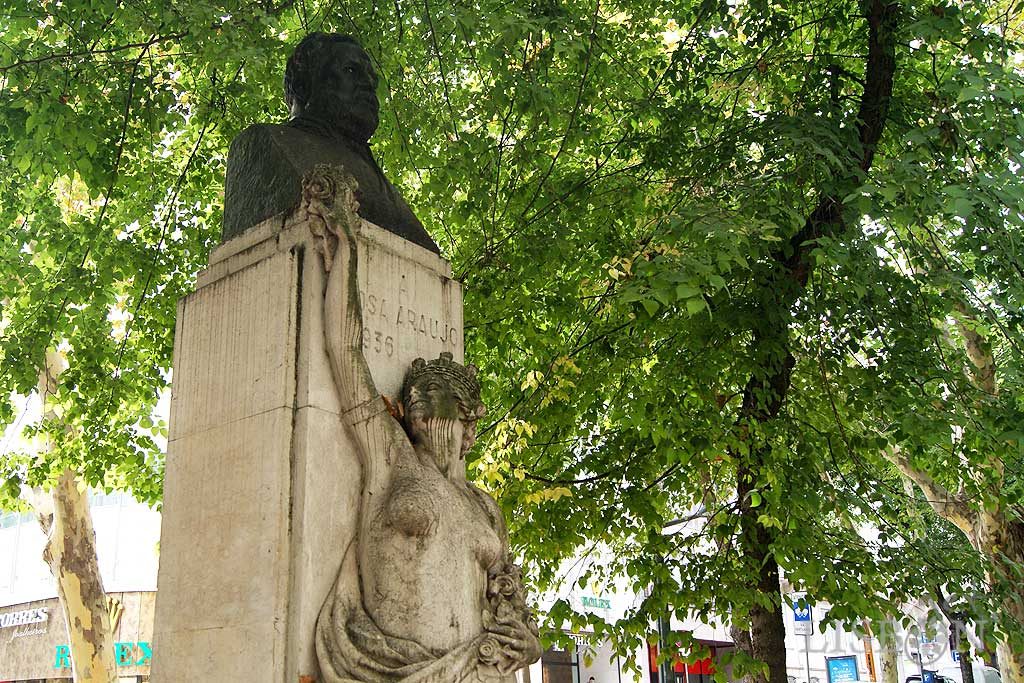
We continue going down the avenue and when crossing with Rua Rosa Araújo, we find a sculptural set of tribute to this personality.
José Gregório da Rosa Araújo (1840-1893), president of the City Council of Lisbon between 1878 and 1885, was the leader of the controversial project of restructuring the city, which aimed to expand it up north. The opening and name of Liberdade Avenue are both owed to him.
To pay homage to this personality this monument was erected in 1936, initially placed in a corner between Rua Rosa Araújo and Rua Mouzinho da Silveira, having been transferred to its current location in 1945.
This was a late art piece of the sculptor Costa Motta – nephew (1877-1956). This realist bronze bust stands on a stone pedestal characterised by classic and austere lines, which in contrast, features a curvaceous representation of a feminine figure in Art Nouveau style.
This crowned woman represents the city of Lisbon and its gratefulness for the responsible person of its development.
Perhaps its aesthetic was already a bit outdated for the mid-1930s, but it is still an exemplar of great beauty that we should admire.
The Monument to the Great War Dead
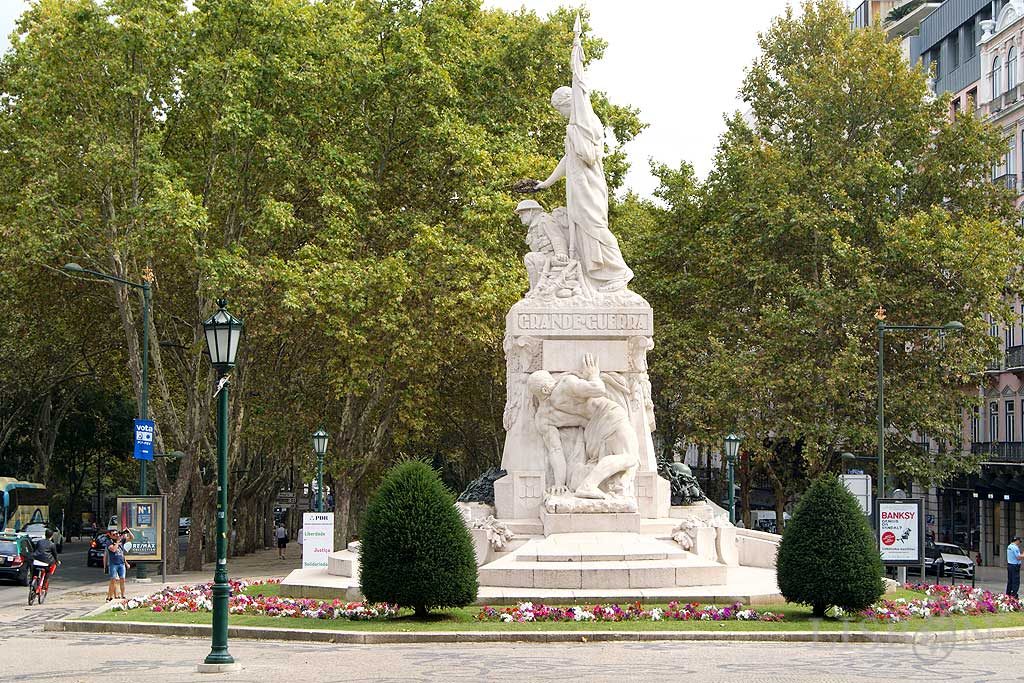
Midway through the avenue, in front of Rua do Salitre, we can observe an ampler space in whose centre is the monument of tribute to the deceased of the World War I (1914-1918), in which Portugal was a part of.
The idea of erecting this monument arose in 1920 and the first stone was laid three years later by the president of the republic at the time, Dr. António José de Almeida.
After several controversial tenders and difficult fundraisings, the current project was chosen.
Created by the sculptor Maximiano Alves (1888-1954) and the architect brothers Guilherme Rebelo de Andrade (1891-1969) and Carlos Rebelo de Andrade (1887-1971), it was inaugurated on November 22, 1931.
Built in stone, the base of the monument is shaped like a christ cross and is placed on an octagonal-shaped lawn.
Two sturdy masculine figures that symbolise will and strength are strenuously supporting the protagonist figures of this monument: the “victorious homeland”, a standing feminine figure that’s wielding a flag and crowning the kneeling Soldier with a laurel wreath.
The monumental completion of the pavement surrounding the monument took place after the construction of the metro in the late 1950s.
Carefully observe it and you might find some of the fun interventions we’ve written about in the article Curious Secrets in the Portuguese Pavement in Lisbon.
Allegory to the Douro River
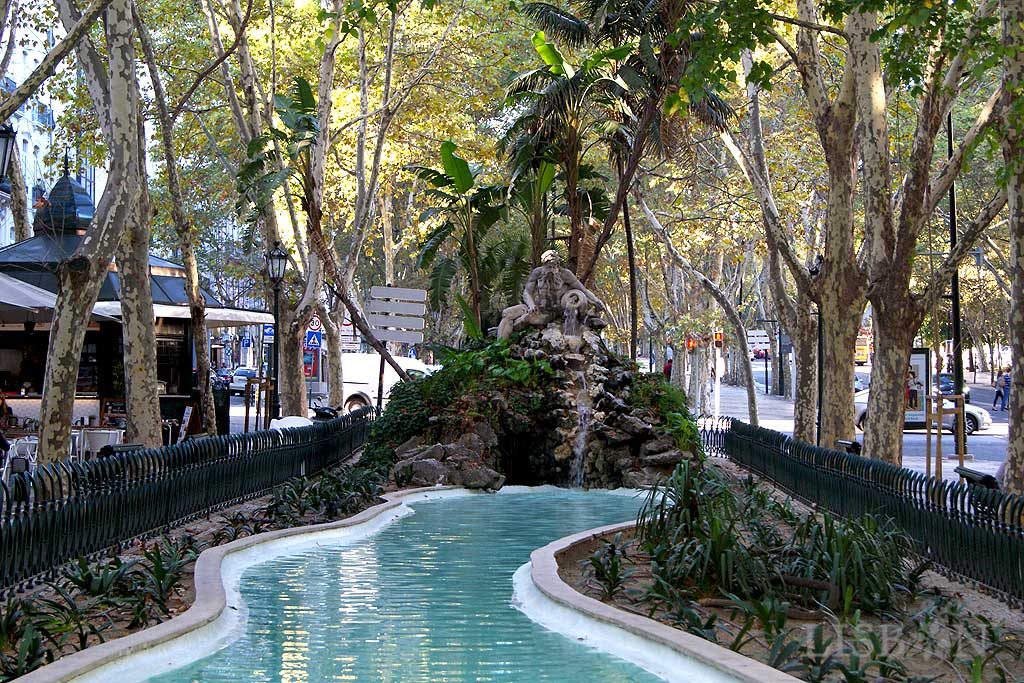
When crossing Rua da Alegria, you will feel like you’ve entered an older part of the Liberdade Avenue. Right away we notice that the pavement design is different. You can find out why in our article The Origins of the Portuguese Pavement and Its First Exemplars.
The stretch all the way to Restauradores Square used to be the old Public Promenade, a fenced garden that was only frequented by the elites of Lisbon in the 1800s and that was closed in 1879 with the opening of the Liberdade Avenue.
Here you’ll find a serpentine pond with a waterfall on its north end. This waterfall features a stone sculpture of a long-bearded masculine figure holding a pot from where the water is flowing. This sculpture represents the Douro River, while on the east side we’ll find a similar one representing the Tagus River.
They were both made by Alexandre Gomes (1772-1775), one of the sculptors that participated alongside Machado de Castro in the creation of the equestrian monument of King José. The allegories to the rivers were initially projected to integrate a monumental fountain that would be located on Santana Hill that was never concretised. Today, there are many parts of this project spread across the city. These two elements were placed in the Public Promenade in 1836 and have stayed here since then.
| Never miss another article | Subscribe here |
Cast Iron Decorative Pieces
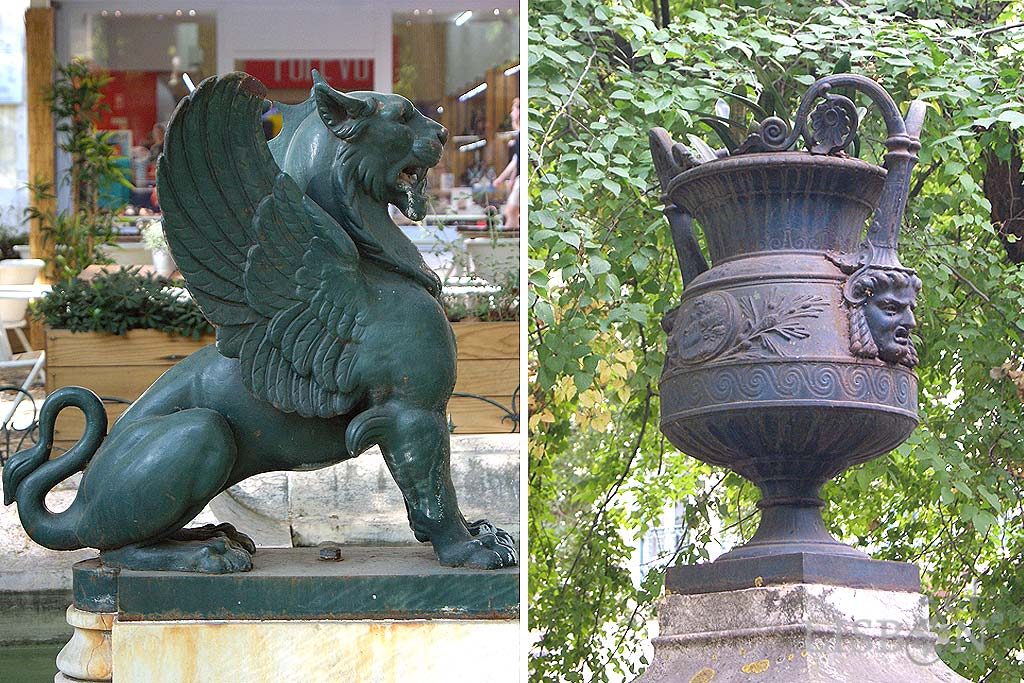
The last sculptures we can find before reaching Restauradores Square are painted cast iron decorative elements.
These were probably from a French mass production and reveal a neoclassical style. They are, nonetheless, peculiar elements worth mentioning and preserving.
They’re two big vases decorated with cameos, plant-inspired or geometric motifs, as well as figureheads. These vases are standing on two pedestals on the sides of a stone pond. Plus, on the ends of this pond, there are two lions whose mouths flow water.
Fun fact: these lions that very often go unnoticed and that are even sometimes called griffins, are identical to the famous lions of the fountain in Gomes Teixeira Square, commonly known as Lions Square, in Porto. Those lions were placed there in 1882 by the initiative of Water Company of Porto.
Regarding these lions here in Lisbon, we could only find them referenced in the ironic criticism of Rafael Bordalo Pinheiro in the issue of January, 7, 1886 of his newspaper Pontos nos ii.
With this, we end our walk through the sculptures or Liberdade Avenue – West.
Note: Original article published on 9 October 2019.
The project getLISBON has been very rewarding and we want to continue revealing the singularities of fascinating Lisbon.
Help us keep this project alive!
By using these links to make your reservations you’ll be supporting us. With no extra costs!
• Looking for a different experience? We can create a customised itinerary based on your interests. Contact us!
• Or if you prefer tours and other activities in various destinations, take a look at GetYourGuide.
• Save time and money with a flexible Lisbon Card!




